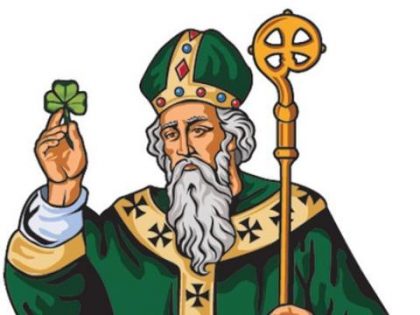Shamrockin’ through history

This image was accessed via Google Images under the Creative Commons License.
This portrait of St. Patrick can be found in Patrick’s Cathedral in Dublin, Ireland and other cathedrals in New York, New York and Melbourne, Australia.
It may come as a surprise, but St. Patrick’s Day hasn’t always been about Lucky Charms, Shamrock Shakes and Shamrock Macchiatos. It has, however, been symbolized by, the color green and shamrocks since the 1790s. And, for those who don’t know, St. Patrick’s Day is celebrated on the anniversary of St. Patrick’s death, March 17. The color green was originally adopted by the Irish to show rebellion and shamrock, or three-leaf clover, became the symbol of the rebellion.
The color green represents the Catholic faith and the Irish nationalist view. The Society of the United Irishmen began to wear green to support the end of discrimination in Northern Ireland.
St. Patrick didn’t have the most ideal upbringing in life. He was born in Roman Britain but got kidnapped and became a slave in Ireland. St. Patrick eventually escaped but returned to bring Christianity to the Irish, which is why he’s honored by this holiday.
When St. Patrick introduced the Irish Christianity, he used the three-leaf clover (Shamrock) as a representation of the Holy Trinity: the Father, the Son and the Holy Spirit. The Irish view these clovers as faith, hope and love; if a four-leaf clover is found, the fourth petal represents luck.
St. Patrick’s Day occurs during the Christian and Catholic holiday season of Lent, a time where the Catholics fast in preparation for Easter. However, these prohibitions on the first celebration of St. Patrick’s Day were lifted and the Irish would dance, drink and feast on Irish bacon and cabbage.
The Irish also had a difficult time once some immigrated to America. Many Americans were targeting them because they believed the Irish were trying to overturn the American Protestant and democratic society. This eventually led to famine and poverty for the Irish between 1845 and 1855.
However, President Truman was the first to notice the pride of the Irish people in their New York City parade in 1948. It was the first true acceptance in the New World for the Irish-Americans.
Now, there are parades in almost every city in America. The most famous one is the parade in Chicago where the entire Chicago River is dyed green and has been every year since 1962. Some of the other biggest parades are in St. Louis, Washington D.C. and Pittsburgh.
Hopefully, by next St. Patrick’s Day, a little more love is given toward this green-filled holiday than just wearing green and drinking a shamrock shake.
When Kayla isn’t in school you can catch her rewatch the same movies or shows (especially the After and Gilmore Girls series) over again, working on...








